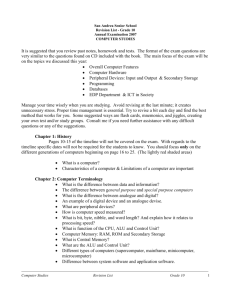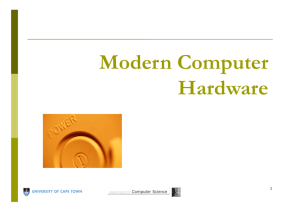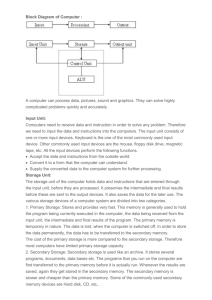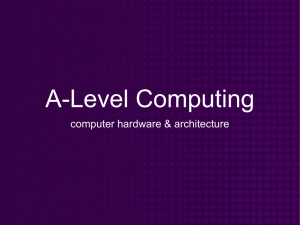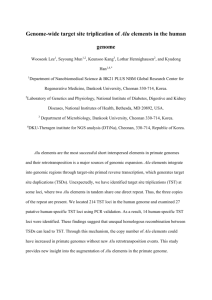Lecture 8: Microprogramming (Appendix D)
advertisement
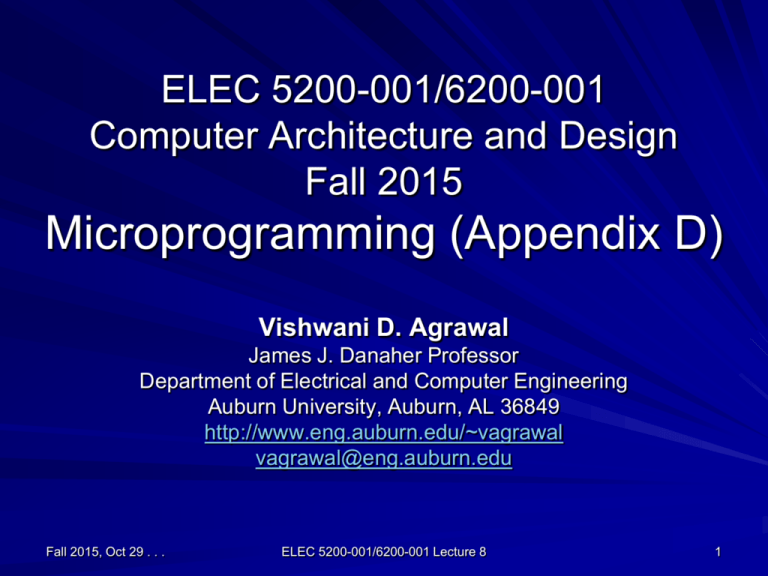
ELEC 5200-001/6200-001 Computer Architecture and Design Fall 2015 Microprogramming (Appendix D) Vishwani D. Agrawal James J. Danaher Professor Department of Electrical and Computer Engineering Auburn University, Auburn, AL 36849 http://www.eng.auburn.edu/~vagrawal vagrawal@eng.auburn.edu Fall 2015, Oct 29 . . . ELEC 5200-001/6200-001 Lecture 8 1 Alternatives for Control Unit (CU) Hard-wired (hardware) – Random logic, programmable logic array (PLA), or ROM – Fast – Inflexible Firmware – Microprogrammed or microcoded CU – Control implemented like a computer (microcomputer) Microinstructions Microprogram – Flexible Software-like changes to instruction set possible Completely different instruction sets can be emulated – Speed limited by microcomputer memory Fall 2015, Oct 29 . . . ELEC 5200-001/6200-001 Lecture 8 2 IRWrite MemRead MemWrite Fall 2015, Oct 29 . . . RegWrite 0-15 Sign extend 0-5 ELEC 5200-001/6200-001 Lecture 8 ALUOut Reg. ALU ALUSrcB ALUSrcA B Reg. Register file 11-15 RegDst A Reg. 28-31 16-20 MemtoReg PCSource Shift left 2 21-25 Mem. Data (MDR) Data 0-25 Instr. reg. (IR) IorD Memory 26-31 to Control FSM Addr. PC PCWrite etc. Multicycle Datapath 4 Shift left 2 ALU control ALUOp 3 Multicycle Control FSM Inputs: 6 opcode bits Outputs: 16 control signals Start State 0 1 Instr. decode/reg. fetch/branch addr. Instr. fetch/ adv. PC R 3 2 Read memory data Compute memory addr. lw 5 Write register Fall 2015, Oct 29 . . . B ALU operation 6 Write PC on branch condition 8 sw 4 J Write jump addr. to PC 9 7 Write memory data Write register ELEC 5200-001/6200-001 Lecture 8 4 States and Outputs Suppose 10 states are encoded 0000 through 1001. State code completely determines 16 control signals (Moore machine). States 0 (0000), 3 (0011) and 6 (0110) Next state ← present state + 1 State 1 (0001) – opcode determines next state State 2 (0010) for lw or sw State 6 (0110) for R-type of instruction State 8 (1000) for branch instruction State 9 (1001) for jump instruction State 2 (0010) – opcode determines next state State 3 (0011) for lw State 5 (0101) for sw States 4 (0100), 5 (0101), 7 (0111), 8 (1000) and 9 (1001) – next state is unconditionally 0 (0000) Fall 2015, Oct 29 . . . ELEC 5200-001/6200-001 Lecture 8 5 A Program-Like Implementation Inputs: 6 opcode bits Outputs: 16 control signals Start State 0000 0001 Instr. decode/reg. fetch/branch addr. Instr. fetch/ adv. PC 0011 Read memory data R 0010 lw Compute memory addr. ALU operation J B Write PC on branch condition Write jump addr. to PC 0110 0100 Write register Fall 2015, Oct 29 . . . 0101 sw 1000 1001 0111 Write memory data Write register ELEC 5200-001/6200-001 Lecture 8 6 Implementing with ROM Control PLA or ROM 16 words 16 16 control signals 2 4 PLA input or ROM address Select one of 4 ways Four flip-flops State sequencer 6-bit opcode Fall 2015, Oct 29 . . . 6 ELEC 5200-001/6200-001 Lecture 8 7 ROM and State Sequencer Control ROM Sixteen 18-bit words 4-bit address 0001 16 2 AddrCtl 00 11 01 10 Address 4 4 4-bit state flip-flops Adder Advance state MUX 11 10 01 00 6-bit Opcode from IR Fall 2015, Oct 29 . . . sw or lw go to st. 0 st. + 1 st. 2,6,8,9 st. 3,5 0000 4 Dispatch ROM 2 Control signals to datapath Dispatch ROM 1 ROM Address 6 ELEC 5200-001/6200-001 Lecture 8 sw, lw, R, B or J 8 Dispatch ROM Contents Each dispatch ROM has sixty-four 4-bit words Address is 6-bit opcode Content is next state (4-bits) Dispatch ROM 1 Dispatch ROM 2 Instruction Address (Opcode) Content Instruction Address (Opcode) Content lw 100011 0010 lw 100011 0011 sw 101011 0010 sw 101011 0101 R 000000 0110 B 000100 1000 J 000010 1001 Fall 2015, Oct 29 . . . ELEC 5200-001/6200-001 Lecture 8 9 Control ROM Contents Control ROM has sixteen 18-bit words: – bits 0-1, AddrCtl to control mux – bits 2-17, sixteen control signals for datapath Address is 4-bit state of control machine Fall 2015, Oct 29 . . . Addr. bits 17-2 bits 1-0 0000 1001010000001000 11 0001 0000000000011000 01 0010 0000000000010100 10 0011 0011000000000000 11 0100 0000001000000010 00 0101 0010100000000000 00 0110 0000000001000100 11 0111 0000000000000011 00 1000 0100000010100100 00 1001 1000000100000000 00 ELEC 5200-001/6200-001 Lecture 8 10 Microprogram: Basic Idea The control unit in a computer generates an output (sequence of control signals) for each instruction. Suppose we break down each instruction into a series of smaller operations (microinstructions), such as, fetch, decode, etc. Then, implement the control unit as a small computer (within the computer) that executes a sequence of microinstructions (microprogram) for each instruction. M. V. Wilkes, “The Best Way to Design an Automatic Calculating Machine,” Report of Manchester University Computer Inaugural Conference, pp. 16-18, 1951. Reprinted in E. E. Swartzlander (editor), Computer Design Development: Principal Papers, pp. 266-270, Rochelle Park, NJ: Hayden, 1976. Fall 2015, Oct 29 . . . ELEC 5200-001/6200-001 Lecture 8 11 Maurice V. Wilkes Born June 26, 1913, Staffordshire, UK, died November 29, 2010 1967 Turing Award citation: Professor Wilkes Is best known as the builder and designer of the EDSAC, the first computer with an internally stored program. Built in 1949, the EDSAC used a mercury delay line memory. He is also known as the author, with Wheeler and Gill, of a volume on “Preparation of Programs for Electronic Digital Computers” in 1951, in which program libraries were effectively introduced. Fall 2015, Oct 29 . . . ELEC 5200-001/6200-001 Lecture 8 12 Microcoded Control Unit Microcode word Sixteen Microcode 18-bit words memory 4-bit address 0001 Address 4 4 μPC 4-bit state flip-flops 16 Control signals to datapath AddrCtl Sequencing 2 field MUX 11 10 01 00 Adder 0000 Opcode from IR Dispatch ROM 2 lw or sw Dispatch ROM 1 ROM address 6 Fall 2015, Oct 29 . . . ELEC 5200-001/6200-001 Lecture 8 sw, lw, R, B or J Address select logic 13 Implementing the Idea Use a memory type implementation for control unit. Create a software infrastructure to automatically translate instructions into memory data (microcode): Microinstructions – define a machine language in which instructions can be described Microprogram – an instruction described as a sequence of microinstructions Microassembler – converts microprogram to (binary) microcode Is there a micro-compiler? Fall 2015, Oct 29 . . . ELEC 5200-001/6200-001 Lecture 8 14 Microprogramming A microinstruction set is defined. To program the control of a computer for an instruction set, a programmer writes a microprogram for each machine instruction. Each micrprogram is converted into microcode, specific to the datapath hardware, by a microassembler and the entire microcode is loaded in the microcode memory of the control unit (CU). Fall 2015, Oct 29 . . . ELEC 5200-001/6200-001 Lecture 8 15 Breaking Up MIPS Instructions R-type instruction: Fetch Decode ALU operation Write register lw: Fetch Decode Memory address computation Read memory Write register Fall 2015, Oct 29 . . . ELEC 5200-001/6200-001 Lecture 8 16 Microinstructions for MIPS ISA Fetch Decode RegWr LWSW1 LW2 SW2 R1 BEQ1 JUMP1 Fall 2015, Oct 29 . . . fetch instruction decode instruction, read registers, calculate branch address write register compute memory address memory read memory write register type execution branch execution jump execution ELEC 5200-001/6200-001 Lecture 8 17 Let’s Construct MIPS Instructions sw: R-type instruction: Fetch Decode R1 RegWr Fetch Decode LWSW1 SW2 Branch: lw: Fetch Decode LWSW1 LW2 RegWr Fall 2015, Oct 29 . . . Fetch Decode BEQ1 Jump: Fetch Decode JUMP1 ELEC 5200-001/6200-001 Lecture 8 18 Microinstruction Format Just one instruction with seven arguments A label or name for control state(s), e.g., Fetch, MEM1, etc. Seven arguments and their possible values: – – – – ALU control SRC1 SRC2 Reg. control – Memory – PCWrite – Sequencing Fall 2015, Oct 29 . . . add, subtract or funct. code # result to ALUOut PC or A B, 4, extend or extend-shift Read # read two reg. specified by IR into A and B Write ALU # write ALUOut to register file Write MDR # register file ← MDR Read PC # IR ← M[ PC ] Read ALU # MDR ← M[ ALUOut ] Write ALU # M[ ALUOut ] ← B ALU # write PC from ALU ALU cond. # If zero = 1, PC ← ALUOut Jump addr. # PC ← jump address Seq # choose next μInst. Sequentially fetch # go to first μInst. to begin new instr. Dispatch i # use Dispatch ROM i, i = 1 or 2 ELEC 5200-001/6200-001 Lecture 8 19 Sequencing Illustrated State 0 Fetch Sequencing 1 = seq Instr. fetch/ adv. PC Fetch Instr. decode/reg. fetch/branch addr. Dispatch 1 3 2 LW2 Read memory data Compute memory addr. lw 6 5 Write register SW2 Write memory data seq JUMP1 BEQ1 ALU operation seq 4 R1 LWSW1 Write PC on branch condition 8 Write jump addr. to PC 9 7 Write register Fetch Fall 2015, Oct 29 . . . ELEC 5200-001/6200-001 Lecture 8 20 Microinstruction Arguments Argument ALU Ctrl SRC1 SRC2 Value μCode value Action Add ALUOp = 00 ALU adds Subt ALUOp = 01 ALU subtracts for beq Funct code ALUOp = 10 ALU executes R-type instruction PC ALUSrcA = 0 PC is first ALU input A ALUSrcA = 1 Reg A is first ALU input B ALUSrcB = 00 Reg B is second ALU input 4 ALUSrcB = 01 Constant 4 is second ALU input Extend ALUSrcB = 10 Sign extension unit is second ALU input Extshft ALUSrcB = 11 2-bit shift unit is second ALU input Fall 2015, Oct 29 . . . ELEC 5200-001/6200-001 Lecture 8 21 Microinstruction Arguments (Cont.) Argument Reg. Ctrl Memory Value μCode value Read Action Load A and B from Register file Write ALU RegWrite = 1 RegDst = 1 MemtoReg = 0 An IR-specified register in Register file is written from ALUOut Write MDR RegWrite = 1 RegDst = 0 MemtoReg = 1 An IR-specified register in Register file is written from MDR Read PC MemRead = 1 IorD = 0 IRWrite = 1 IR ← M[ PC ] MDR ← M[ PC ] Read ALU MemRead = 1 IorD = 1 MDR ← M[ ALUOut ] Write ALU MemWrite = 1 IorD = 1 M[ ALUOut ] ← B Fall 2015, Oct 29 . . . ELEC 5200-001/6200-001 Lecture 8 22 Microinstruction Arguments (Cont.) Field μInstr. value μCode value Action PCSource = 00 PCWrite = 1 Register file loads A and B PCSource = 01 PCWriteCond = 1 An IR-specified register in Register file is written from ALUOut PCSource = 10 PCWrite = 1 An IR-specified register in Register file is written from MDR AddrCtl = 11 Choose next μInstr. sequentially AddrCtl = 00 Go to first μInstr. to begin new instruction Dispatch 1 AddrCtl = 01 Use Dispatch ROM 1 Dispatch 2 AddrCtl = 10 Use Dispatch ROM 2 PC Write ALU Ctrl ALUOutcond Jump address Sequenc Seq ing Fetch Fall 2015, Oct 29 . . . ELEC 5200-001/6200-001 Lecture 8 23 Microinstruction Fetch Label ALU ctrl. SRC1 SRC2 Reg. ctrl. Mem. PCWrite ctrl. Fetch Add Decode Add PC PC Read PC ALU Fall 2015, Oct 29 . . . Read Seq Dispatch 1 ELEC 5200-001/6200-001 Lecture 8 Addrctl PCSource PCWrite PCWriteCond MemRead IorD IRWrite MemWrite RegWrite RegDst MemtoReg ALUSrcB Microassembler produces the following microcode: 0 01 0 0 0 1 0 1 0 00 1 0 11 0 11 0 0 0 0 0 0 0 00 0 0 01 ALUSrcA ALUOp 00 00 4 ExtShft Seq. 24 Microprogram for lw and sw Label ALU ctrl. SRC1 SRC2 Reg. ctrl. LWSW1 Add LW2 RegWr SW2 A Mem. PCWrite ctrl. Extend Read ALU Write MDR Write ALU Seq. Dispatch 2 Seq Fetch Fetch Microprogram consists of four microinstructions. Fall 2015, Oct 29 . . . ELEC 5200-001/6200-001 Lecture 8 25 Microprogram for R-Type Instruction Label ALU ctrl. SRC1 SRC2 Reg. ctrl. R1 RegWr A Funct code Mem. PCWrite ctrl. B Write ALU Seq. Seq Fetch Go to next μInstr. Go to μInstr. Fetch Microprogram consists of two microinstructions. Fall 2015, Oct 29 . . . ELEC 5200-001/6200-001 Lecture 8 26 Microprogram for beq Instruction Label ALU ctrl. SRC1 SRC2 Reg. ctrl. BEQ1 A Subt Mem. B PCWrite ctrl. Seq. ALUOut-cond Fetch If (zero) then PC ← ALUOut Go to μInstr. Fetch Microprogram consists of one microinstruction. Fall 2015, Oct 29 . . . ELEC 5200-001/6200-001 Lecture 8 27 Microprogram for jump Instruction Label ALU ctrl. JUMP1 SRC1 SRC2 Reg. ctrl. Mem. PCWrite ctrl. Seq. Jump address Fetch Microprogram consists of one microinstruction. Fall 2015, Oct 29 . . . ELEC 5200-001/6200-001 Lecture 8 28 μProgram for Multi-Cycle CU Label ALU ctrl. SRC1 SRC2 Fetch Add Decode1 Add PC PC 4 ExtShft LWSW1 Add LW2 RegWr SW2 A Extend R1 RegWr FntCd. A BEQ1 Subt Reg. ctrl. Mem. PCWrite ctrl. Seq. Read PC ALU Seq Disp. 1 Read Disp. 2 Seq Fetch Fetch Read ALU Write MDR Write ALU B Seq Fetch Write ALU A B JUMP1 Fall 2015, Oct 29 . . . ELEC 5200-001/6200-001 Lecture 8 ALUOut-cond Fetch Jump address Fetch 29 IRWrite MemRead MemWrite Fall 2015, Oct 29 . . . RegWrite 0-15 Sign extend 0-5 ELEC 5200-001/6200-001 Lecture 8 ALUOut Reg. ALU ALUSrcB ALUSrcA B Reg. Register file 11-15 RegDst A Reg. 28-31 16-20 MemtoReg PCSource Shift left 2 21-25 Mem. Data (MDR) Data 0-25 Instr. reg. (IR) IorD Memory 26-31 to Microcoded Control Addr. PC PCWrite etc. Multicycle Datapath 4 Shift left 2 ALU control ALUOp 30 Microcode Operation μPC is always initialized to 0000 Load starting instruction address in PC Clock control and datapath Fall 2015, Oct 29 . . . ELEC 5200-001/6200-001 Lecture 8 31 How Microcode Works 0001 in clk 2 0001 4 4 Sixteen Microcode 18-bit words memory 4-bit address μPC Address 0000 16 clk 1: Set Datapath for Fetch AddrCtl Sequencing 11 field MUX 11 10 01 00 Adder 0000 Opcode from IR In clk 2 Dispatch ROM 2 lw or sw Dispatch ROM 1 ROM address 6 Fall 2015, Oct 29 . . . ELEC 5200-001/6200-001 Lecture 8 sw, lw, R, B or J Address select logic 32 Multicycle Control FSM Inputs: 6 opcode bits Outputs: 16 control signals Start State 0 1 Instr. decode/reg. fetch/branch addr. Instr. fetch/ adv. PC R 3 2 Read memory data Compute memory addr. lw 5 Write register Fall 2015, Oct 29 . . . B ALU operation 6 Write PC on branch condition 8 sw 4 J Write jump addr. to PC 9 7 Write memory data Write register ELEC 5200-001/6200-001 Lecture 8 33 Summary Hard-wired control: A finite state machine implemented typically using programmable logic array (PLA) or random logic. Microinstruction: A one-clock instruction that asserts a set of control signals to the datapath and specifies what microinstruction to execute next. Microprogram: A sequence of microinstructions that implements a multicycle (or single cycle) instruction. Microcode: Machine code of a microprogram, generally produced by a microassembler. Microprogrammed or microcoded control: A method of specifying control that uses microcode rather than a finite state machine. Fall 2015, Oct 29 . . . ELEC 5200-001/6200-001 Lecture 8 34 Further on Microprogramming Preceding discussion is based on: D. A. Patterson and J. L. Hennessey, Computer Organization and Design, Second Edition, San Francisco: Morgan-Kaufman, 1998, Chapter 5, pp. 399-410. Terms “microcomputer”, “microarchitecture” and “micropipeline” are not related to microprogramming. Nanoprogramming: Two levels of microprogramming – a “recursive” control: Nanodata Corp., QM-1 Hardware Level Users Manual, 2nd Ed., Williamsville, NY, 1972. J. P. Hayes, Computer Architecture and Organization, Section 4.4.3, NY: McGraw-Hill, 1978. Virtual machines: Any program can be run on any instruction set using an interpreter. Example, Java. Fall 2015, Oct 29 . . . ELEC 5200-001/6200-001 Lecture 8 35


